Blog
Archives
.
. . from 2012 to current
WEDNESDAY
JUNE 24 - 2015
Brook
Meadow
I had a walk
through the meadow this morning. The grasses are
looking and feeling great. I stopped to admire the
delicate rounded leaves of the tall Aspen tree
on the east side of the north meadow. Its leaves
flutter in the light breeze, with a gentle rustling
noise.
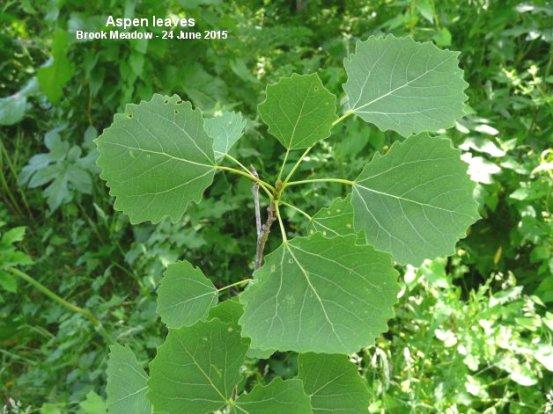
This tree was planted
on 22 Dec 2005 which makes it 10 years old. And what a
size it is already. The tree was donated by members of
the Haskins family in memory of their mother who used
to live in Lumley Hall.
The dark crimson
flower heads of the rare Great Burnet
(Sanguisorba officinalis) now stand out
clearly on the southern section of the orchid area.
The flowers are crowded into dense oval shaped spikes
at the top of the stems. All the flowers on Great
Burnet are bisexual with 4 short stamens and an
undivided stigma. These can just be seen opening at
the top of the flower head in the photo.
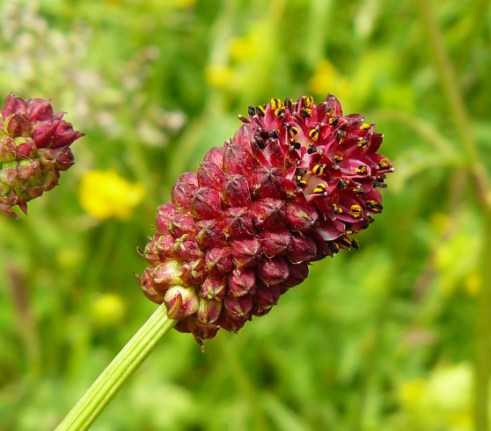
I counted a total of
48 flowering Great Burnet plants in four clusters.
This is a large increase over the 28 that I counted
last year.
Bee Orchids are
still looking good in the main orchid area, though the
Southern Marsh Orchids are well past their best. Most
of the Common Spotted Orchids are also going
over, though the two nestling beside a Meadowsweet
bush are still pretty good.
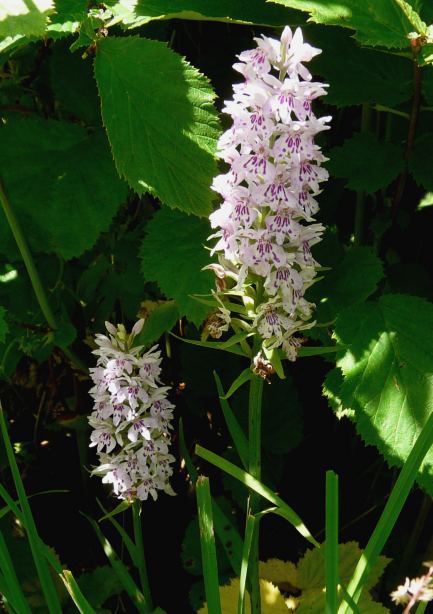
I found more Smooth
Brome (Bromus racemosus) - an uncommon
grass - on the east side of the Lumley area.
Meadowsweet is almost out; give it a week or so
and it will be a mass of aromatic fluffy flowers.
I met a young chap
with filming equipment on the meadow who told me he
was making a film for his portfolio. He hoped it would
get him a job. I said the conservation group would be
interested to see his film so he gave me his card for
me to e-mail him and said he would get in touch when
the film was done.
Red
fungi
Chris Oakley
found some fungi with bright red caps growing on the
grass at the front of his house in North Emsworth. He
thinks they are called Ruby Bolete (Boletus
rubellus). Chris says they keep reappearing
despite the regular grass cutting. The books say they
are generally found in the autumn beneath oak trees.
Well they're beneath oaks but it's not autumn
yet.
Mystery
plants
Chris Oakley
says one of the plants on the Nursery Close wayside,
which were thought at first to be Charlock is now just
short of 9 feet tall! The others which are partly
shaded by the tree are at 7 feet plus. One wonders
where it will stop.
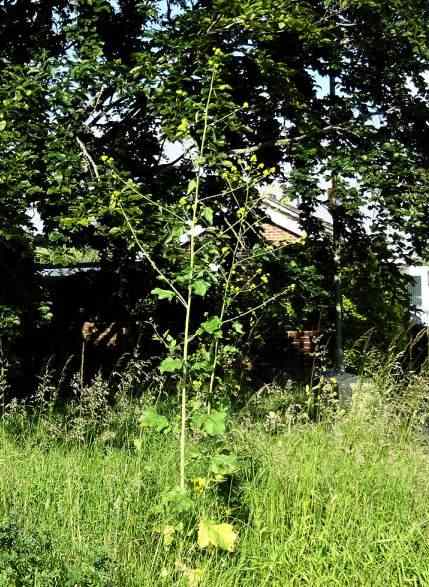
Ralph Hollins says "My
guess is currently that your plants may be Black
Mustard which Stace's Flora says can grow to 2
metres high though I have found a photo on the
internet of a plant that seems to be higher than
that.
See . . . https://risingspirit.files.wordpress.com/2010/03/tall_mustard.jpg
A diagnostic feature of Black Mustard is that after
flowering the seed pods do not stick out at an angle
from the main stem but are tightly pressed against it.
If you want to see that I mean go to Emsworth
Marina/Yacht Harbour and walk all the way round it to
the footpath running along its west side (overlooking
Emsworth Harbour) where there are many plants of Black
Mustard (though none of your plant's height!)"
Black Mustard grows well on the western sea wall of
Emsworth Marina if you want to check it. Go through
the boatyard until you come to the harbour and then
turn right down a dead end path.
Conigar
Point
Peter
Milinets-Raby was out this morning (6:05am to 8:15am -
tide high, then dropping slowly). His report
follows:
"Because the path to Conigar Point was looking
overgrown and dew covered (and I did not fancy getting
wet - lazy I know), I walked all the way to Nore Barn
from Warblington Church and back. The bird highlights
were as follows:
Ibis Field: Pheasant heard, Blackcap heard singing,
Chiffchaff 2 heard singing, 1 Moorhen, 2 Stock
Dove.
Big field on way to Nore Barn: 1 Skylark singing,
Great Spotted Woodpecker over.
West corner of Nore Barn Wood by small stream: Cetti's
Warbler heard singing, Chiffchaff singing, Blackcap
heard singing.
Nore Barn: 8 Shelduck, 2 Redshank, 3 Great
Black-backed Gulls, 4 Canada Geese, Skylark over pond
field, 2 Great Crested Grebe (way out).
Off Conigar Point: 1 Little Gull (1st summer). There
for most of the morning, as I delayed myself taking
photos of the Tamarisk flowers - very attractive at
the moment.
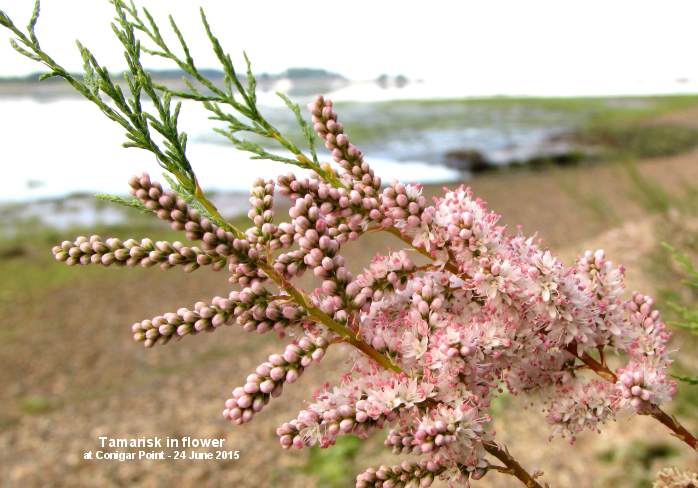
4 Common Tern,
Whitethroat singing, 8 Shelduck (different from Nore
Barn), 63 Herring Gulls (most semi adults), 2 Lesser
Black-backed Gulls (semi adults - of interest: a pair
with at least two tiny chicks have bred on the factory
roof of the rear of the Colt Building off New Lane,
Havant), 2 Mute Swan, Cetti's Warbler, Reed Warbler
and Reed Bunting singing from small reed bed.
Sparrowhawk over with prey item. 9 Curlew, 4 Redshank,
1 Sandwich Tern, 1 Little Tern, 2 Med Gulls (adult and
first summer).
Off Pook Lane: Whitethroat in SSSI field, 61 Herring
Gulls (again mostly semi adults), 2 Great Crested
Grebes, 1 Redshank, 2 female type Red Breasted
Mergansers, AND 1 fledged Black-headed Gull juvenile.
TUESDAY
JUNE 23 - 2015
Emsworth
Waysides
I had a cycle
around some of the local waysides this morning,
catching up on some of the plants as Jane and I have
not been able to get together for our regular surveys
so far this year. I headed through Washington Road and
the Emsworth Recreation Ground before cutting across
to Christopher Way and then up to the Westbourne Open
Space. My final destination was the Hampshire Farm
open space site where I stopped for lunch before
having a little mooch around.
Washington
Road path
The embankment
outside Glenwood School was burgeoning with grasses
and bramble. However, the pale rose pink flowers of
Musk Mallow immediately stood out from the
jungle. Great to see them. My first of the year and a
first for this wayside.
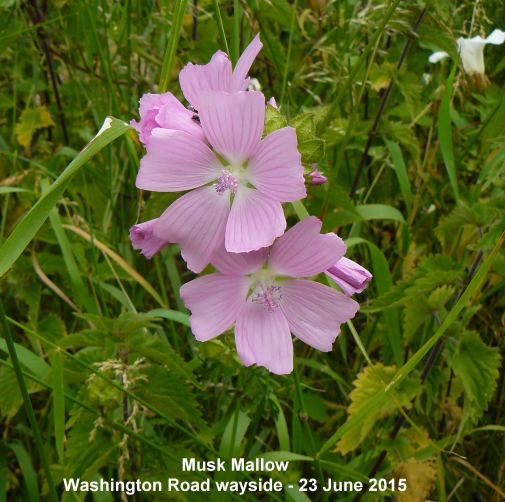
I had another good
find a little way down the path towards the park. This
was a Cranesbill with very tiny flowers which I think
could be Small-flowered Crane's-bill. This
differs from the more common Dove's-foot Cranesbill
mainly in its smaller and pale dingy lilac flowers.
There was some Dove's-foot Cranesbill nearby to
compare it with so felt fairly confident about the
identification. It was just north of the metal gates.
Grid Ref: SU 74612 06370. Please correct me if I am
wrong.
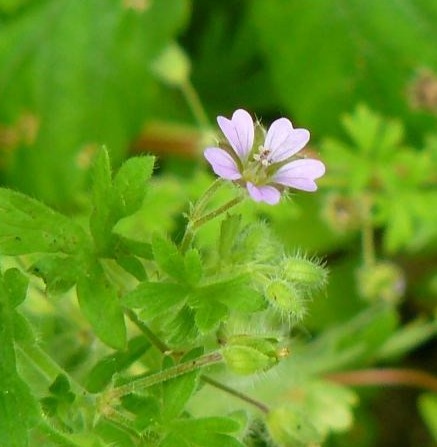
Ralph Hollins says "My
test for Small Flowered Cranesbill is to get out my
hand lens and look at the flower stem (pedicel).
Dove's Foot Cranesbill can have small flowers but the
pedicel will have at least a few long hairs - Small
Flowered has all the hairs uniformly
short."
It was good to see
Meadow Barley again in the same place as for
the past two years near the metal gate leading to the
highways track. A magnificent Hogweed in full flower
was my first of the year. The very rare Greater
Burdock (Articium lappa) were severely cut
back last year by the Council strimmers, but are
growing again. The leaves are prominent, but no
flowers as yet.
Emsworth
Recreation Ground
The grassland
to the west of the bowling club is looking very good
with an excellent variety of grasses and flowers. Grid
Ref: SU 74513 06675. The bent grasses that I puzzled
over last time I was here are now opening, but I am
still not sure what they are. With their long ligules,
I have always put them down as Creeping Bent in the
past. However, examining the spikelets closely with
the microscope I found they had long bent awns coming
from the lemmas. This would be very unusual in
Creeping Bent, so my tentative guess was for Velvet
Bent-grass. I asked Martin Rand who thought this was
unlikely and suggested instead Highland Bent
(Agrostis castellana) though he
would need to see the grass itself in order to be
sure. Highland Bent apparently is a common constituent
of sport field sowing, so the habitat fits. Also, it
has long ligules and long bent awns so it seems to fit
the bill.
Meadow Browns were fluttering around and a Chiffchaff
was singing from the bushes. Chiffchaffs have started
singing again over the past couple of days.
Christopher
Way wayside
The path
leading from Bellevue Lane has been well and truly
strimmed, so there is nothing left, not even the
Shining Cranesbill. On the wayside itself, the Wild
Clary plants are still present, but finished
flowering. There was a possible Smaller Cat's-tail -
or it could be a small Timothy. I am never 100% sure
about these two grasses. I was pleased to find a
couple of plants of Knotted Hedge-parsley on
the edge of the footpath near the Wild Clary sign -
almost as rare as the Wild Clary.
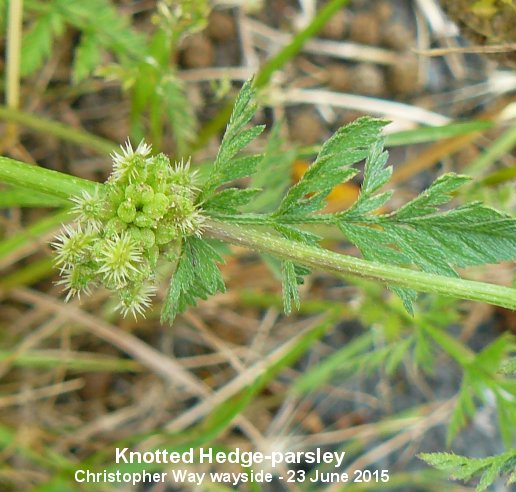
Westbourne
Open Space
As expected
the grassland was full of grasses swaying in the light
breeze. A great sight. Timothy is dominant plus
plenty of what I think is Smaller Cat's-tail.

Hampshire
Farm
I settled down
on one of the seats near the car park to have my lunch
which I had brought with me. I was surrounded on all
sides (and even on the seat itself) by a colourful
variety of flowers, dominated by Oxeye Daisies and
White Clover and Fescue grasses swaying in the light
breeze. Meadow Browns fluttered by on their quest for
nectar. There was not a human being in sight apart
from a chap working on the nearby allotments. It was
idyllic. Bumblebees were constantly buzzing around the
clovers with bulging pollen sacs for the nests. I
think this one could be a Bombus terrestris
worker.
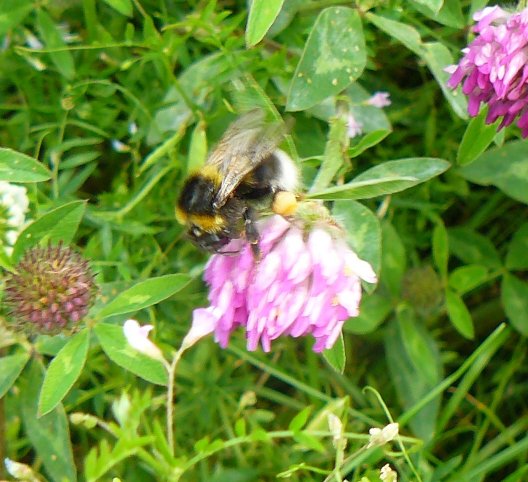
I had a close look at
the Tare which was tangled around other plants
immediately in front of the seat where I sat for
lunch. I established that it was Smooth Tare
from double lilac flowers and 4-seeded pods. Hairy
Tare would have more flowers in clusters with two
seeds in the pods.
Just behind my seat I
could see some of the large dark plantain-type
heads that puzzled Chris Oakley on June 17th. They
were much larger and darker than the regular Ribwort
Plantain heads which were also present in the same
area. The stems were also thicker and heavily grooved.
I pulled a plant up to have a look at the leaves (in
the cause of science) which were also plantain-like.
So, it remains a mystery.
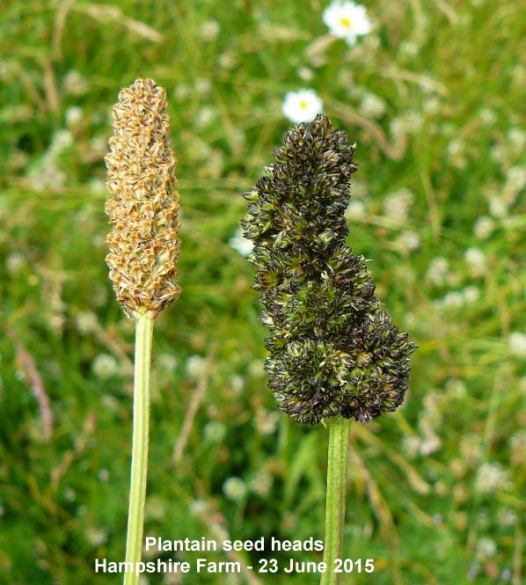
Chris Oakley has
alerted us to the presence of Alsike Clover on
the Hampshire Farm site, presumably originating from
the commercial seed mixes used on the site.
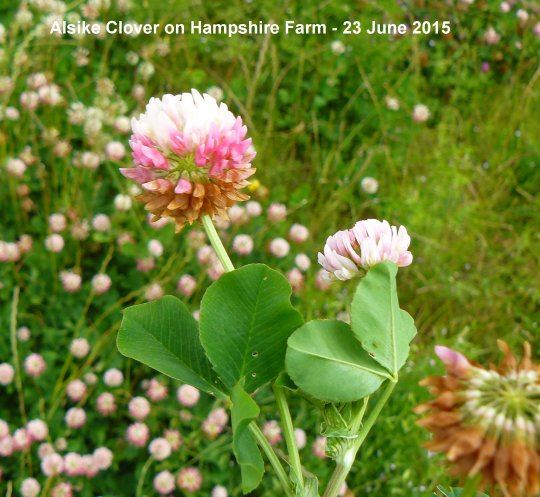
Alsike Clover needs a
close look to distinguish it from the more common
White Clover. One difference is the pink colouring of
the Alsike Clover flowers, though White Clover can
also have this pink flush occasionally. Some of the
Alsike Clovers on the Hampshire Farm site are very
pink. The structure of the plants also differs in that
stems of White Clover root in the ground from which a
long leafless stem rises with the cluster of flowers
at the top. This does not happen in Alsike Clover in
which the flower stem arises from the leaf axils.
Another key difference is in the leaves; those of
Alsike Clover lack the white chevrons that are usually
(not always) present on White Clover. Other flowers
noted on the site included Common Knapweed,
Corn-cockle, Selfheal, Lesser Trefoil, Hop Trefoil,
Marbled
Whites
Tony and
Hilary Wootton had several Marbled White butterflies
on a walk down the west side of Thorney Island between
the two deeps today. These were the first I have had
reported locally.
Fern
Grass correction
I am grateful
again to Philip Marshall from Todmorden for pointing
out what might be another error in my identification
of the pavement grasses in St James Road. Philip says
the Fern grass photographed in yesterday's blog does
not look like the ones in Todmorden and he thinks it
is Sea Fern (Catapodium marinum).
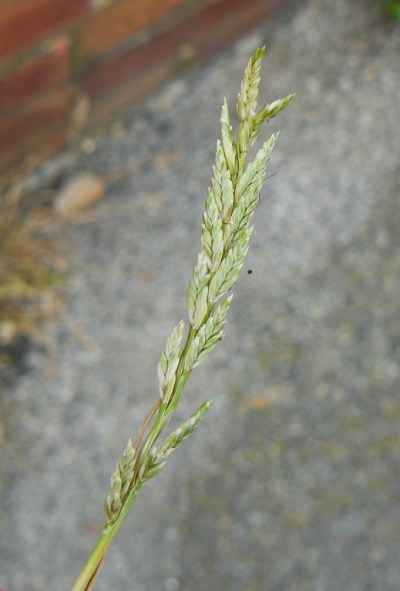
He points out that
Fern Grass (C. rigidum) has pinnate
spikelets whereas Sea Fern Grass C.
marinum has alternating rows of spikelets a
bit like a small rye grass. It is usually seen at the
coast but he has heard it is spreading along salted
highways.
Looking at the illustrations in Francis Rose:
"Grasses, Sedges, Rushes and Ferns" (Plate 2), the two
grasses clearly differ in appearance. As Rose says,
the spikelets in Sea Fern Grass are arranged
alternately along the two sides of the main
inflorescence axis - not along side branches in a
twice-pinnate arrangement as in Fern Grass.
I had another close look at the grass this morning and
can confirm that all the panicles are the same with
spikelets arranged alternately as in Sea Fern Grass;
none were arranged pinnately as needed by Fern Grass
(Catapodium rigidum).
The photo of the plant shows a small and largely dead
Water Bent grass growing to the right of the Sea Fern
Grass.
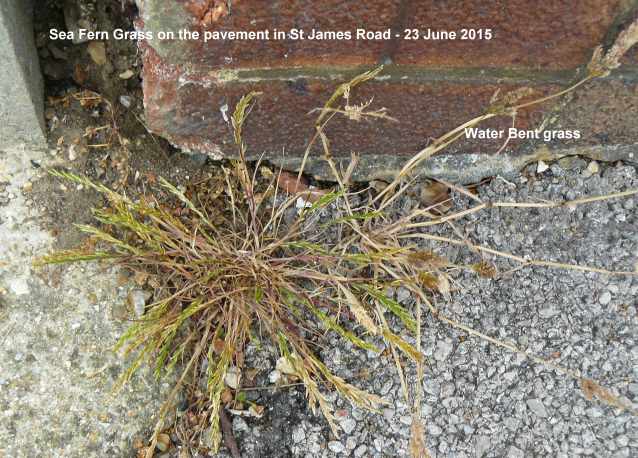
I sent Martin Rand the
BSBI Recorder for South Hants my photos of the
pavement grasses. He confirmed the identification of
Water Bent (Polypogon viridis). But he could
not confirm the Fern Grass Catapodium species
without seeing it. Martin says it needs measurements
and close examination. The degree of branching in the
panicle isn't a reliable character. He asked me to
send him a bit which I will do. It will be good to get
this cleared up.
MONDAY
JUNE 22 - 2015
Painted
Lady invasion?
In his
wildlife diary Ralph Hollins provides a link to the
butterfly conservation web site where you can read
more about the possible invasion of Painted Ladies
this year.
See . . . http://butterfly-conservation.org/48-9304/the-lady-descends--again.html

Ralph adds two points
of interest regarding the Painted Lady migration.
Firstly, they do not make non-stop flights from Africa
to this country but make their journey in stages.
Those that started from north Africa will have stopped
somewhere in France or Germany where they will have
laid eggs from which a new generation will have
developed to continue north. Secondly, the migration
regularly (but not always) takes place at heights of
up to 1 kilometre and at speeds of up to 30 miles an
hour. This has been revealed recently by using
sensitive radar to detect large flocks of butterflies
that could not be seen from the ground.
See . . . http://ralph-hollins.net/Diary.htm
Grass
correction
I am very
grateful to Philip Marshall for indicating that the
grass I photographed growing on the driveway of number
37 St James Road was in fact Water Bent and not Fern
Grass (see blog for June 19).
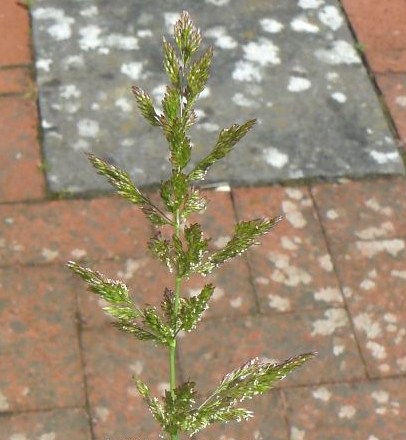
Philip said that Fern
Grass grows in his local town (Todmorden in West
Yorkshire) and it is not as tall as Water Bent. Also,
the panicle of Fern Grass is flatter in one plane,
rather than branched around the stem like Water Bent.
The silvery look to the spikelets are also a good
guide to the 'jizz' of Water Bent. A very good tip,
the St James Road grass is indeed very silvery. Water
Bent - Grid Ref: SU 74732 06005
I checked the St James Road grass again this morning
and Philip is spot on. In fact, my first thought when
I saw the grass on June 19 was Water Bent, but I was
put off by its long ragged ligules which the book says
is characteristic of Fern Grass. But everything else,
including the single flowered spikelets, clearly
indicates Water Bent.
I had a look around
when checking the Water Bent today and actually found
Fern Grass growing no more than 10 metres away
on the adjacent driveway outside house number 35 St
James Road. I am fairly sure this is where I found it
before. As Philip said, Fern Grass is quite different
in appearance to Water Bent, shorter, having a flatter
panicle and spikelets with several flowers.
Interestingly, there appears to be a small bit of
Water Bent growing beside the Fern Grass! Fern Grass -
Grid Ref: SU 74740 05999
Here
is Fern Grass in situ

Here
is a close-up of a Fern Grass
panicle
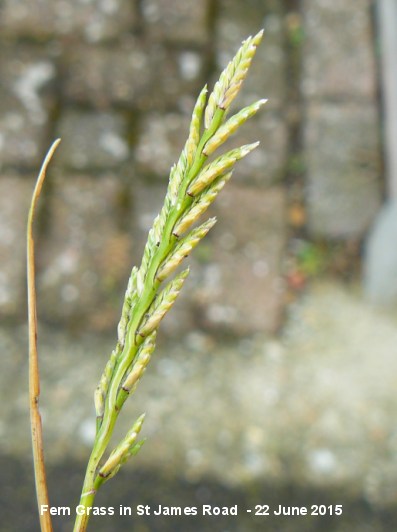
I would really
appreciate hearing of any other examples of these
grasses around Emsworth. They typically come up on
driveways, by walls and in cracks on pavements.
Other
news
I had a wander
around the Hermitage Millponds this morning. Common
Ragwort is now in full flower on the south side of
Peter Pond and Perennial Sow-thistle also out
on the east side of Peter Pond. I also noticed
Rough Chervil on the edge of Lumley Road almost
opposite the house called Cambercroft where I recall
Pipistrelle Bats used to roost in the roof some years
ago. Cetti's Warbler and Chiffchaff were singing away
from Lumley copse. Rough Chervil - Grid Ref: SU 75152
06077.
The grass False Brome used to grow well along
this verge, but the bank has become very overgrown
with brambles, which means it is now restricted to a
small area close to where the Lumley Cottages begin.
False Brome can be distinguished from the more common
Barren Brome by its much shorter panicle stalks.

Garden
visitors
I had some
interesting visitors to my garden today. First was a
pair of Jackdaws on the bird table. I rarely
saw Jackdaws anywhere in Emsworth until last year, but
now their sharp 'jyack-jyack' calls are heard on a
daily basis and they sometimes drop into the garden. I
assume they must be nesting somewhere in the town.
Does anyone know where?
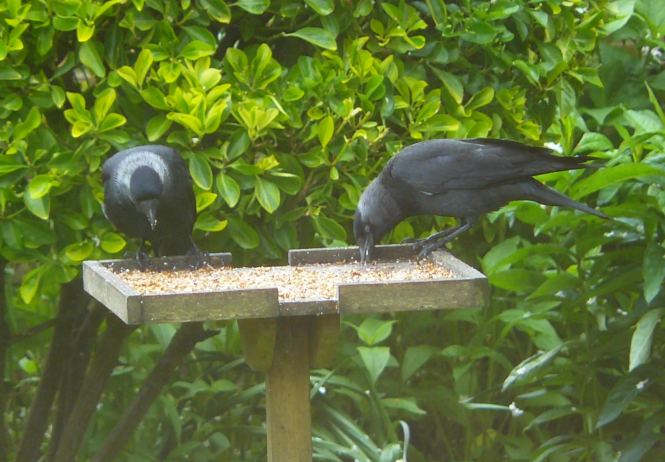
The second unusual
visitors was a family of Magpies - one adult
and two youngsters were on the grass for a few minutes
this morning. One Magpie is fairly common, two are
less so, but three are really unusual. I don't recall
having seen a family in the garden before.
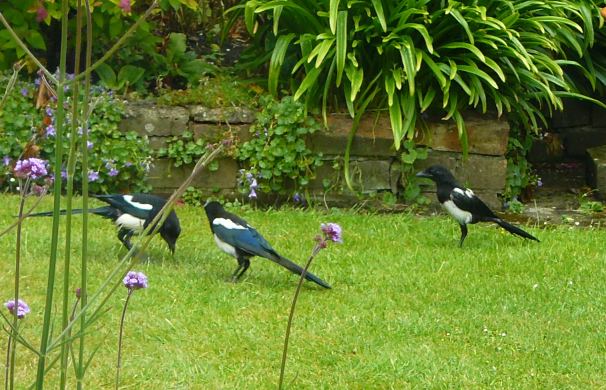
Langstone
Mill Pond
Peter
Milinets-Raby briefly popped down to the Langstone
Mill Pond this afternoon (2:30pm to 3:30pm). Main
observations as follows:
Wade Lane: 1 Buzzard sat in the usual tree, Blackcap
still singing.
Flooded Horse paddock: 4 Grey Heron, 2 Moorhen.
Langstone Mill Pond: 3 singing Reed Warblers heard
with two seen, 1 Cetti's Warbler heard, Mallard with 4
ducklings, Kestrel, 54+ Little Egrets counted with at
least 20+ just roosting.
Off shore (last bit of high tide tide pushing in):
Swan family with 6 cygnets, 2 summer plumaged Great
Crested Grebes, 1 Sandwich Tern, On the last bit of
salt marsh before flying off 2 Lapwing and a single
Redshank (the first I have seen for over a month -
first returning birds?). 20+ Swifts over (stormy
weather tempting them to feed over the channel), 12
Swallows.
The following is a
link to some photos of Belarusian birds (where Peter
went for his family holiday):
http://www.peterspurplepages.webspace.virginmedia.com/pageeleven.htm
And a short video of
Belarusian birds can be found at:
https://www.youtube.com/watch?v=aKDyYC2FiIw
Francis's
news
Francis
Kinsella was on the Hampshire Farm open space today
and saw lots of Meadow Browns flying and also
Common Blue.

Tonight Francis had a
wander up to Hollybank Woods and saw a rather battered
Red Admiral, a Large Skipper, a spectacular
Broad-bodied Chaser and a Common Lizard hiding
in a pile of twigs.
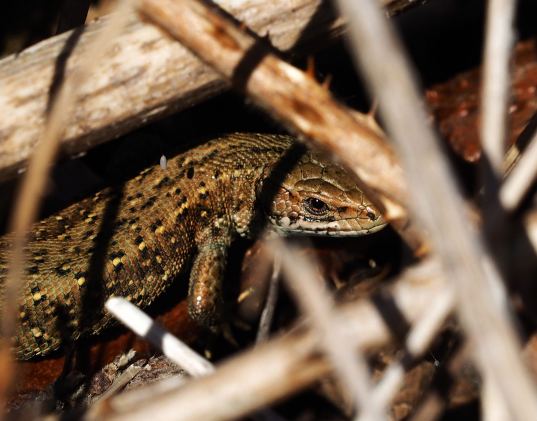
Song
and Mistle Thrush
Tony Wootton
got photos of both of these handsome thrushes in the
New Forest yesterday and presents them here for
comparison. Mistle Thrush is a larger bird with longer
tail and grey upper parts. Mistle Thrush also has
heavier more rounded spots on its underparts that
sometimes coalesce to form a dark smudge on the sides
of the breast not seen too well on Tony's photo.
SUNDAY
JUNE 21 - 2015
Brook
Meadow
I was very
pleased to have the company of Peter and Catherine who
had come all the way from Godalming for this morning's
nature walk through Brook Meadow. They both had
cameras and enjoyed taking shots of the wildlife that
we came across. These included some of our most
spectacular damselflies as follows . . .
Male
Banded Demoiselle
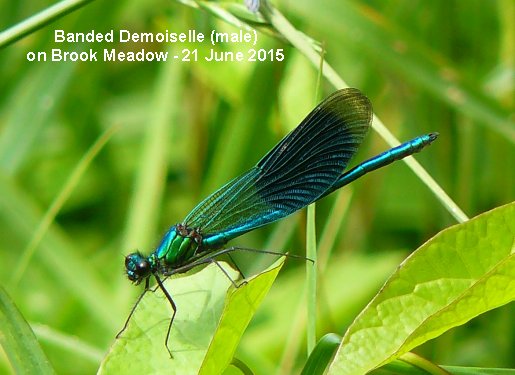
Female
Banded Demoiselle
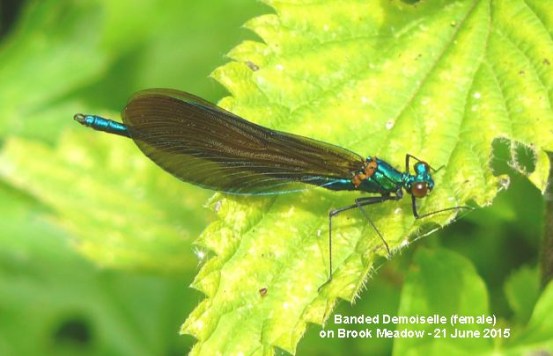
A male
Beautiful Demoiselle with all blue
wings
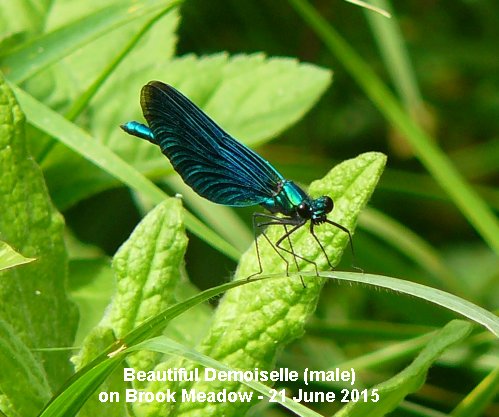
A very
delicate Azure Damselfly.
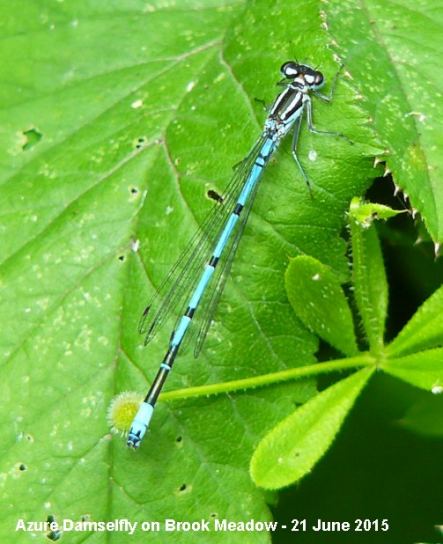
We also spotted hairy
black caterpillars of Peacock butterflies on
the nettles.

Other insects we noted
included a 7-spot Ladybird and a green glossy
beetle with swollen thighs (Oedemera
nobilis).
This is a fairly quiet
time of the year for birds. However, we did hear the
songs of Blackbird, Wren, Blackcap and Whitethroat.
Our resident Cetti's Warbler also exploded into
song briefly from the Lumley Stream area.
Of the wild flowers we noted Common Comfrey and
Hemlock Water-dropwort, but the highlight of the
morning was the Bee Orchids on the main orchid
area which are currently quite stunning, each with two
or three flowers on the stems. Here are Catherine and
Peter taking photos of them.

I also pointed out the
best of our grasses which included Reed Canary-grass,
False Oat-grass and the silky Yorkshire
Fog.
Personally, I was pleased to find the first Common
Couch of the year with awns at the start of the
path round the Lumley area and Meadow Barley on
the eastern path near the arisings tip.
Finally, we went through the Lumley gate to have a
look at the reedbeds on Peter Pond where we could hear
at least two Reed Warblers singing though we
did not manage to see either bird. But, we did see a
rather nice juvenile Long-tailed Tit.
Finally here is a
cracking shot of a Cut-leaved Crane's-bill
flower that I think Catherine took on the Bramble
path.
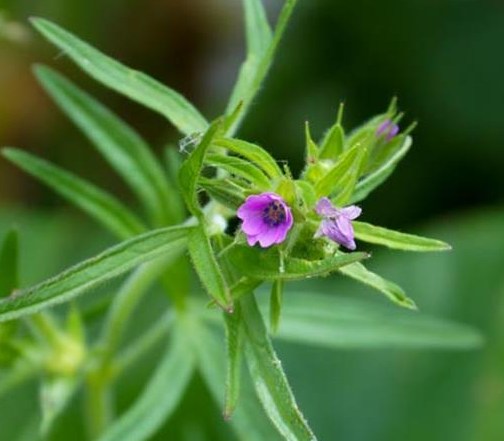
Bee
Orchid
Having admired
the orchids on Brook Meadow yesterday evening, Geoff
Gilbert found another Bee Orchid on the roadside by
the DUCK warning sign on the south side of Peter
Pond.
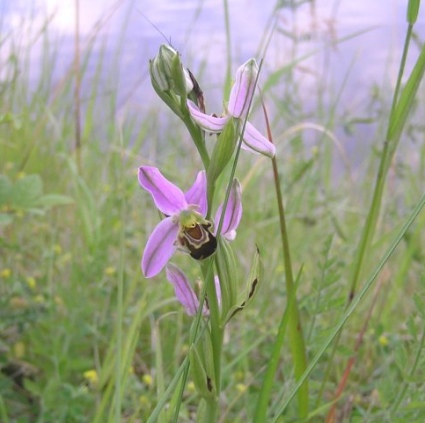
SATURDAY
JUNE 20 - 2015
Guided
nature walk
I will be
leading a nature walk through Brook Meadow tomorrow
morning - Sunday 21st June from 10am to 12 noon. If
you wish to join in please meet in Palmer's Road Car
Park. Children are very welcome, but no dogs please.
Bring your binoculars and camera as you wish.
Painted
Lady invasion?
Every so often
we get a huge invasion of Painted Lady butterflies to
the UK from Africa. The last mass immigration took
place in 2009, when around 11 million descended widely
across the UK, with the butterflies spreading into the
most northerly parts of Scotland. Since then, we have
experienced five years with below average numbers, but
there are indications that 2015 could be very
different. Apparently, Painted Ladies are experiencing
their best year on the continent since 2009 and
unusually high numbers have been seen amassing in
southern Europe at the critical time of the year for
them to spread northwards into Britain. So, keep a
look out for them and let me know. Locally, so far
this year, Chris Cockburn reported at least five
Painted Ladies near Hayling Oysterbeds on Friday June
12th and Joyce Sawyer photographed this Painted Lady
feeding on Hemlock Water-dropwort on Brook Meadow on
June 6th.

Monarch
butterfly in Cosham
Today's issue
of the Portsmouth News (June 20, 2015) had a photo of
a female Monarch butterfly taken by a reader in her
Cosham garden. Butterfly Conservation says there has
been only one other recorded sighting in Hampshire
this year. The Monarch is, of course, a North American
butterfly that famously migrates in vast numbers from
southern Canada and the United states to overwintering
sites in central Mexico.
The big question is did this butterfly come across the
Atlantic Ocean under its own steam? Well, apparently,
it is not impossible. I have been reading an article
which considered four theories to account for the mass
invasion of Monarchs to this country in 1995: (1)
unassisted transatlantic crossing; (2) entirely ship
assisted passage; (3) derivation via the Canaries
and/or Iberian Peninsula; (4) released or escaped
captive-bred insects. The conclusion was that far from
being an 'impossible' oceanic crossing' the Monarch's
chances of safely reaching our shores might be
relatively high if the conditions are right.
See . . . http://www.butterfly-guide.co.uk/help/monmig.htm
However, what does
make me cautious is the ready availability of
butterfly kits on the internet with which one can
easily raise and release one's own butterflies. I have
not tried them, but Brian Lawrence told me his grand
daughter had raised and released some butterflies in
this way. Does anyone know any more about these kits?
Anyway, please keep a look out for Monarchs. Here is a
female like that in Cosham.

Barnacle
Goose family
Eric Eddles
sent me the following shot of a Barnacle Goose family
on Baffins Pond Portsmouth with one remaining gosling
from the original three. Meanwhile, the annual moult
migration of Canada Geese is now underway to Baffins
Pond where there are about 90 present.
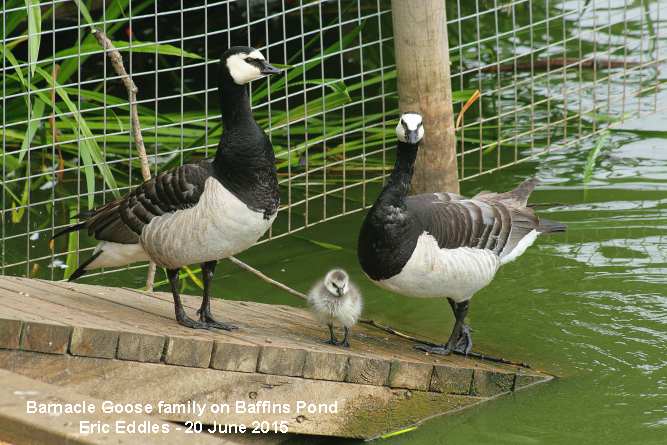
Hampshire
Farm - vote on name!
Havant Borough
Council wants to know what we think should be the name
for the public open space next to the Redlands Grange
housing development in North Emsworth. Most people
(including me) already refer to it as Hampshire Farm
as that was the original name of the farm that was
there before. It's nice and simple, it has a history,
and we all know what we are talking about. However,
HBC wants to make the decision democratic, so they
have thought up some alternative names and want us to
vote. Frankly, I don't see any point in this, as the
site has got a name already which everyone knows and
changing the name is not going to help. Anyway, HBC
gives us a choice of four names: Hampshire Farm,
Redlands, Bournebridge or Ffaroes. I have no idea
where this last choice came from - someone with
Scottish ancestry maybe? We are also given a choice
for the second part of the name, assuming it needs
one: Park, Fields, Meadows or none.
To vote go to . . . http://tinyurl.com/Openspacenaming
. . . before 10th July.
FRIDAY
JUNE 19 - 2015
Swifts
We have had just four Swifts feeding high over the
houses in Bridge Road this morning, not screaming
around as yet. Let's hope numbers build up as the
family parties get going. I expected more this
evening, but nothing. Where are they?
Brook
Meadow - Plant news
I had a walk
through Brook Meadow this morning where Reed
Canary-grass is now in flower with its panicles
towering over all the other grasses on the meadow. A
very fine grass.
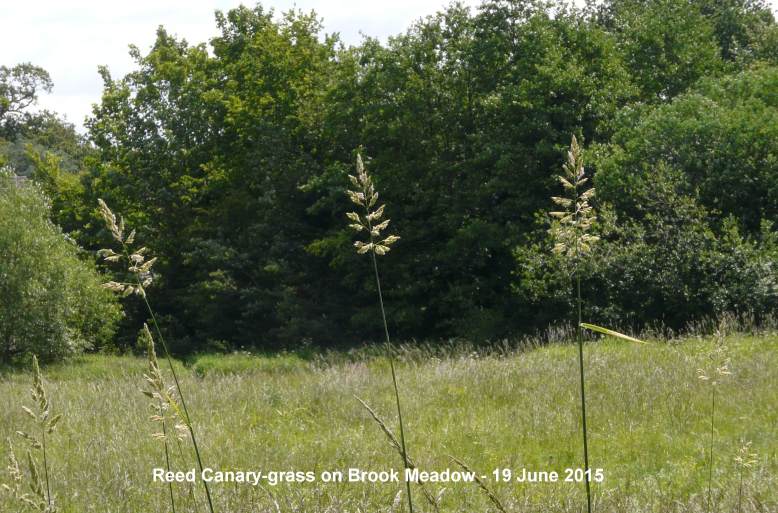
Hedge Bindweed
is now flowering on the causeway. Hedge Bindweed
flowers are always a lot smaller than Large Bindweed
and the green bracts covering sepals overlap only
slightly. In Large Bindweed the bracts overlap and
completely enfold the sepals.
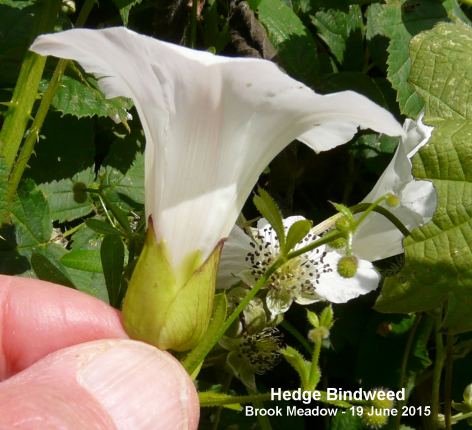
Bulbous Buttercup is
flowering in the far south eastern corner of the south
meadow. The flower had sepals bent back, though this
is also a feature of Hairy Buttercup. The only sure
way of distinguishing the two plants is by digging
them up, which I did not do. Only the Bulbous
Buttercup has bulbous roots. Hedge Woundwort is
flowering in Palmer's Road Copse. False Brome is now
showing on the path through Palmer's Road Copse.
Jill's
news
Jill Stanley
did a recount of the Bee Orchids on the main
orchid area of Brook Meadow today and increased my
count by 6 to a total of 26. Well done, Jill, they are
so easy to miss and more keep coming everyday.
Jill also sent me this
interesting shot of some seed capsules of
Cut-leaved Cranesbill that she took at Stansted
Forest on Wednesday. She says, "We're used to seeing
the little 'candles' that appear after the flowers of
any of the Cranesbill family but I'd never thought
about what happens to them. Rather than describe the
process I think the attached photograph shows it
rather well! I never cease to be amazed by nature!" Me
too.
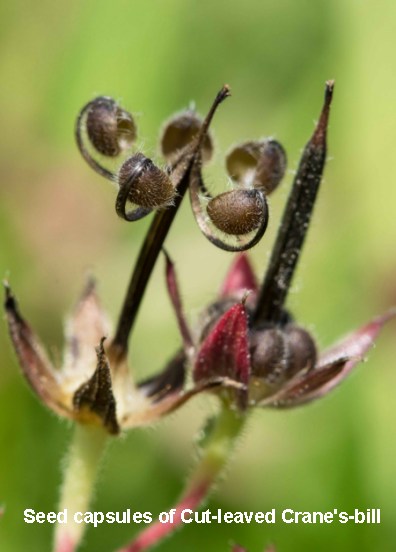
Brian's
news
I met Brian
Lawrence who had just been around Brook Meadow and had
seen several demoiselle damselflies, both Banded
Demoiselle and Beautiful Demoiselle. He also had what
is probably a Narrow-bordered 5-spot Burnet
Moth. This was the first of the year on Brook
Meadow; Malcolm Phillips also had one at this time
last year.
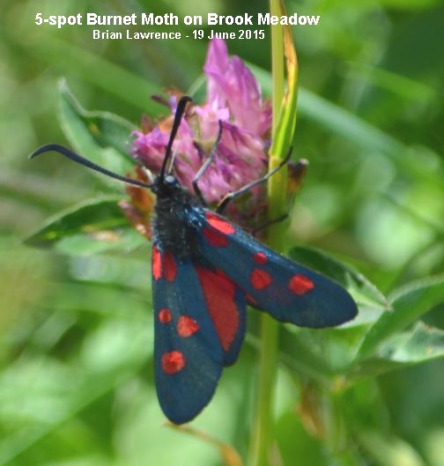
Francis's
News
Francis
Kinsella had the first Ringlet of the year on
Brook Meadow last evening. This could well have been
one of the 'Meadow Browns' that I saw fluttering
around, though they did not stop for me to get a good
look at them. Interestingly, we had our first Ringlet
sighting also on June 18 last year. They are as
regular as clockwork! Francis got photos of both the
brown upper wings and the under wings which have the
distinctive 'ringlets'.
Peter
Pond news
A Reed
Warbler singing from the northern reedbeds when I
passed by this morning. Let's hope it is nesting.
From the small footbridge to the north of the pond, I
could see two Sea Trout in the channel between
the reeds. Sea Trout are similar to the Brown Trout
that we see in the River Ems in having spots, though
they tend to be darker in colour. Sea Trout migrate to
inshore sea areas, returning after a year or more to
spawn in their native rivers. Brown Trout remain in
the river throughout their lives.
One Mute Swan on Peter Pond and another on Slipper
Millpond. Presumably the new pair?
Corncockle is flowering on the east bank.
Formerly an arable weed, it is now more or less
extinct as a native plant. Only found nowadays as the
result of the use of 'wild flower' seed mixes, which
accounts for its presence on the Peter Pond bank along
with other regular colourful constituents of these
mixes, ie Poppies and Cornflowers.

Slipper
Millpond
There was no
sign of the Great Black-backed Gulls on or near the
pond this morning. Maybe, their vigil over the lost
chicks is over? Perennial Sow-thistle is
flowering on the east end of the Hermitage Bridge
overlooking Slipper Millpond. This is very early as I
usually do not see these large yellow daisies until
well into July. The upper stem and bracts are densely
hairy, the hairs tipped with sticky yellow glands.
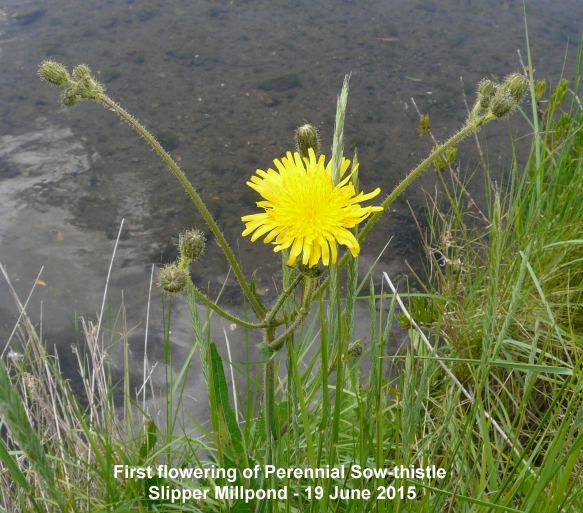
The Coot in the
nest box on the south raft has at least one chick.
Keeping it safe hopefully.
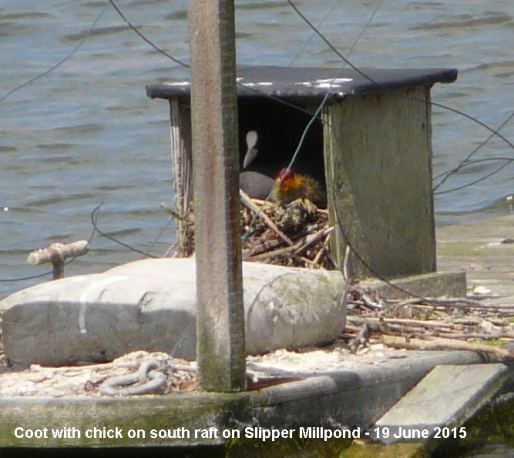
CORRECTION
THIS GRASS IS WATER BENT - see June 22
Fern-grass
(Catapodium rigidum) - A good growth of
this unusual grass is growing well on the edge of the
driveway of house number 37 St James Road. This is a
native species often found in thin bare well drained
soils as in pavements. Common in the South of England.
This grass was first pointed out to me during the
visit of John Norton and Eric Clements (botanists from
the BSBI) and Ralph Hollins on 4 June 2012. It was
also growing in St James Road on that occasion, but
not in this exact spot.
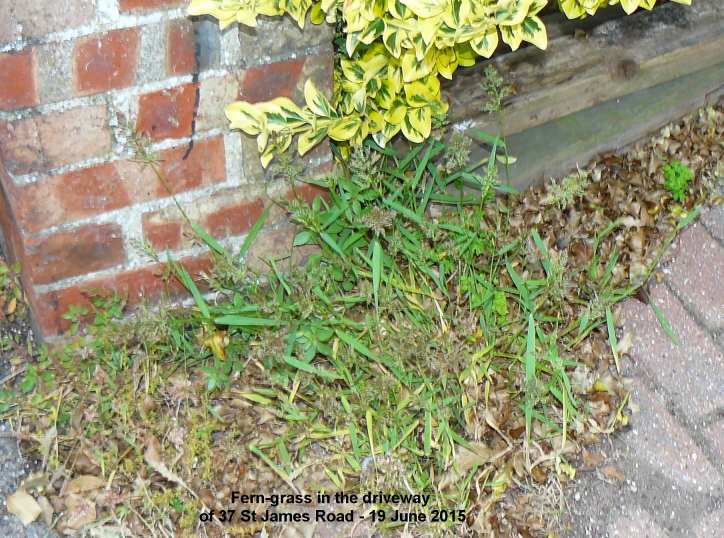
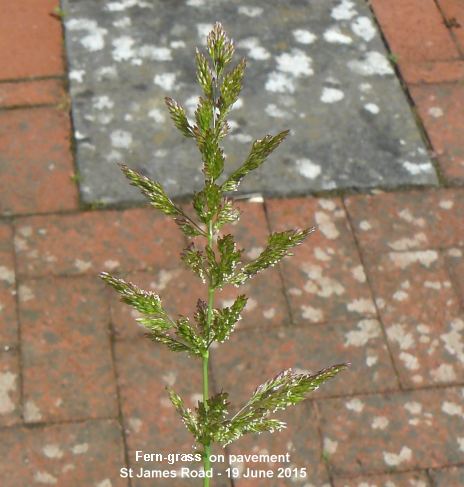
Thomas's
news
Young Thomas
Irons spotted this very spotted Ladybird - probably a
Harlequin - creeping up on a mass of black fly. What a
feast awaits it.

News
from Belarus
Peter
Milinets-Raby received an email back from ecologist
John Norton this morning identifying the Belarusian
flowers he sent him. The flower in John's words was "a
bit stunning and does not occur in the UK." He named
it as Melampyrum nemorosum, a type of
cow wheat.
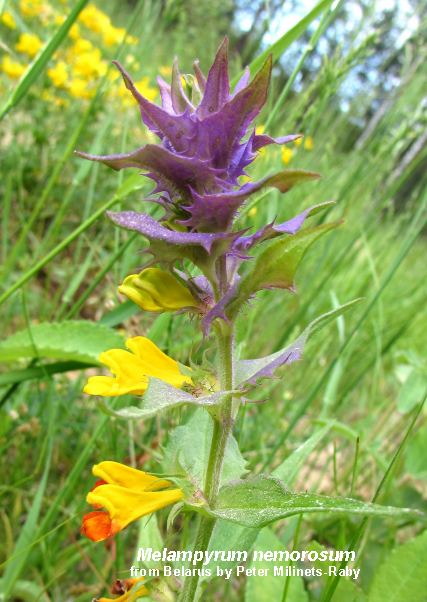
THURSDAY
JUNE 18 - 2015
BROOK
MEADOW
I have to
admit I completely forget about the conservation work
session this morning. So, when I got over to the
meadow for a walk at about 12 noon, I found members of
the work group already completing their work at the
end of the session. I took a few photos of the
volunteers at work for good measure before setting out
to look for orchids and grasses.
Wild
flowers
I found the
first Pineappleweed of the year, smelling very
sweet, near the Seagull Lane gate. Also, the first
Large Bindweed flower of the year on the
Seagull Lane patch which will soon be covered with
these huge white trumpets.
I found another good
patch of 10 Bee Orchids in flower in a small
area just to the west of the northern Hemp Agrimony at
Grid Ref: SU 75064 06139. Here is one of them with a
double flower. This takes the total for the orchid
area to 22 plus the three on the Lumley area makes 25.

The first of the
Common Knapweed is now flowering on the Lumley
area.
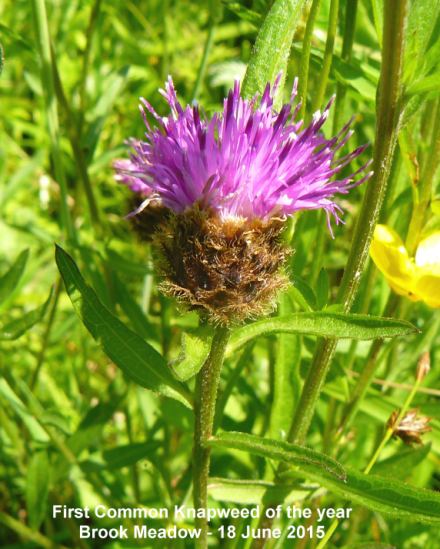
The only butterflies I
saw were a few Meadow Browns fluttering around.
Here is a 'thigh
beetle' (Oedemera nobilis) feeding on
one of the Dog Roses on the Seagull Lane patch.
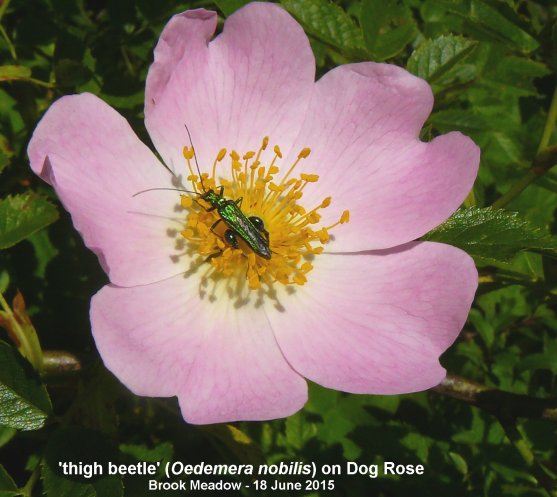
Grasses,
etc
I had a very
good session for finding first of the year grasses on
Brook Meadow.
On the cross path to the west of the Lumley area one
can see both Soft Brome with short branches and
relatively erect panicles and the less common
Smooth Brome with long branches and dropping
panicles.
On the centre meadow I found the first Bent grass of
the year on Brook Meadow. The spikelets were not open,
but the long ligules clearly suggested Creeping
Bent.
Nearby, I found the first spikelets of Meadow
Barley (Hordeum secalinum) which I
also found in this exact spot last year. This is quite
a rare grass on Brook Meadow and I might not find any
more. Grid Ref: SU 675097 06032.

Also coming up in the
same small area were the first young spikelets of
Timothy. They will soon be adorning various
parts of the meadow with their elegant
inflorescences.
Walking up the eastern path through the north meadow I
also came across the first Meadow Fescue
(Festuca pratensis) of the year
along with the Hybrid Fescue xFestulolium
loliaceum which is a hybrid of Meadow Fescue
and Perennial Ryegrass. In the photo one can see the
Fescue-like spikelets arranged up the stem in the
manner of Perennial Ryegrass.

Also, in this area I
found the first Jointed Rush (Juncus
articulatus) of the year. The Sharp-flowered
Rush is not yet in flower on the Lumley area.
WEDNESDAY
JUNE 17 - 2015
Bumblebee
nest
Christine
Gibbs who lives in Church Path Emsworth contacted me
yesterday to say she had Bumblebees nesting in a
disused bird box in her garden. So, this morning I
went round there to have a look and found a highly
active nest with bees constantly coming and going. I
identified the bees which had ginger thoraxes, dark
abdomen and white tail as Bombus
hypnorum (Tree Bumblebee) . This species often
nests in man made structures high off the ground.
Here
is a photo of one feeding on Brook Meadow that I took
a couple of years ago.
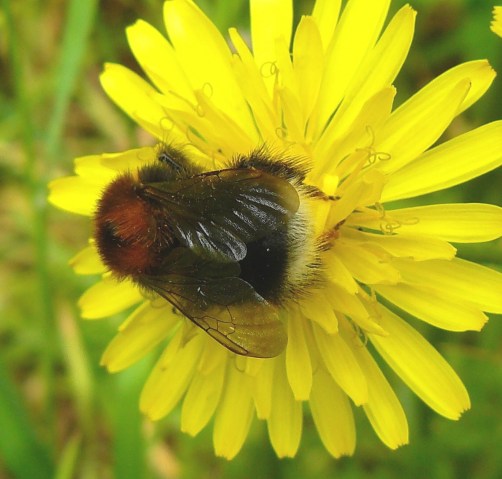
Two years ago my
neighbours had a nest under the eaves in their roof
and only last year my friend Colin Harrington gave me
a nest box with the remains of a Bumblebee nest still
in it. Expert Bryan Pinchen stressed that Bumblebee
nests should not be disturbed as they were not harmful
and would cause no damage. Tree Bumblebees complete
their cycle in early summer and then leave the nest.
Fox
and Cubs
Christine told
me about a mini-survey she had done of the plants
coming up in the pavements in her road with an
impressive list! She alerted me to the Fox and Cubs
that is now flowering on the grass verge near the
flats at the south end of Church path. This verge has
several other interesting plants growing on it,
including Selfheal and Wild Madder. It would make a
nice wayside addition. I assume it belongs to the
flats and is not a council authority verge.

Fox and Cubs which is
also known as Orange Hawkweed is fairly unusual in the
local area; the only other place I know of it is on a
grass verge on Mill Lane past Lumley Mill. I think it
gets its name from the rusty orange mature flower (the
fox) and its flanking buds with fuzzy blackish hair
(the cubs). It was introduced from Central Europe in
the 17thC and since then has become widely
naturalised. It grows well in churchyards, verges and
other grassy places.
Nore
Barn
I cycled over
to Nore Barn to check on the flowers. I found a good
growth of Lax-flowered Sea-lavender on the
saltmarshes to the east of the stream which I have
seen here in previous years. It is, in fact, more
common than Common Sea-lavender in this area. In
Lax-flowered Sea-lavender the flowers are well spaced
out along the stems, whereas in Common Sea-lavender
the flowers are densely packed at the end of the
branches.
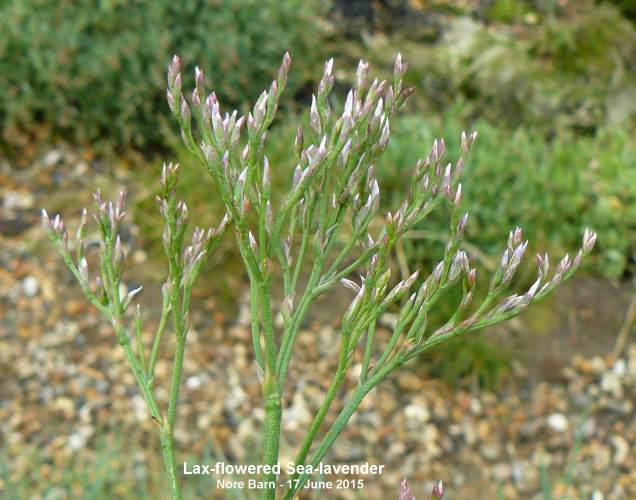
I was interested to
compare the young Sea Couch growing here, with
its tightly overlapping spikelets, and the more spaced
out spikelets of the Sand Couch which I found at East
Head yesterday. The dominant grass on the saltmarshes
is Red Fescue with distinctively red spikelets,
now flowering.
Sea
Couch on the left and Red Fescue on the right
Other plants noted:
Grass-leaved Orache, Glasswort, Sea Plantain, English
Scurvygrass and Field Bindweed (south of woods). In
addition Wild Carrot and Rough Chervil were out on the
path west of woods at Grid Ref: SU 73580 05202.
A Reed Warbler singing in the reedbeds to the north of
Nore Barn.
Farm
field
I went through
to the Warblington Farm field to the west of Nore Barn
Woods to see the interesting plants growing around the
pond which drains into the harbour as suggested by
Ralph Hollins in his diary for 23 May. I was greeted
by an explosive Cetti's Warbler singing from
the bushes at the northern entrance. I was a little
anxious about the small herd of cattle that were
grazing in the field. When they spotted me by the pond
they came over to investigate, but did not come too
close or bother me at all.
Sea
Clover
Following
Ralph's meticulous directions, I located the Sea
Clover (Trifolium squamosum) in on the
embankment between the pond and the barbed wire fence
along the shore. It was easy to find, even though it
had largely finished its flowering period. Grid Ref:
SU 73600 05110. It is a small clover with pale pink
flowers in short-stalked egg-shaped heads with a pair
of leaves at the base. Sea Clover is a nationally
scarce plant and described as 'very rare' in The Hants
Flora. I suspect this is one of the few places one can
see the plant. I believe Ralph Hollins first found it
here in June 2009 and it has been recorded each year
since then.
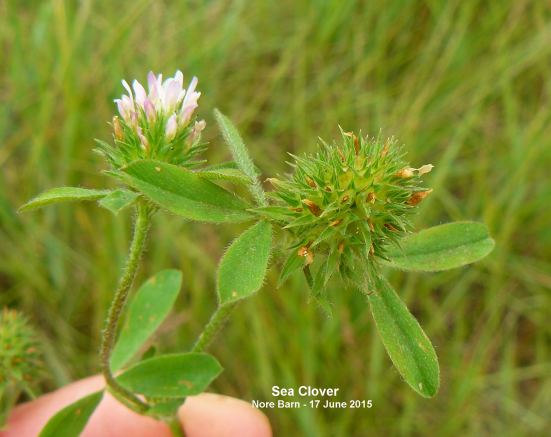
I was also interested
to see the Sea Milkwort that Ralph said was
here as I also found some yesterday at East Head. It
was on the west side of the pond, though far less
abundant than at East Head.

Brookweed was a
big surprise to Ralph as it was the first time in 30
years he had seen it in this field. This plants was
also now in flower on the west side of the pond -
another first for me, not having seen it before.
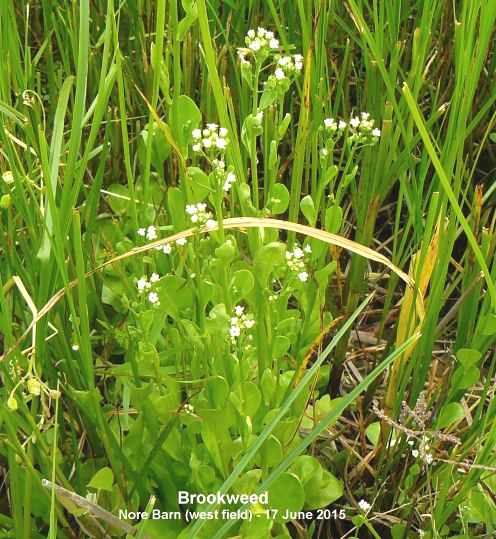
The following photo
shows a view of the farm field looking south with the
approximate locations of the Sea Clover, Sea Milkwort
and Brookweed. The yellow plants could be Heath
Groundsel sprayed by the farmer to prevent the cattle
eating them? Other plants noted in the pond area were
Greater Sea-spurrey, Lesser Sea-spurrey, Sea
Arrowgrass and Celery-leaved Buttercup.
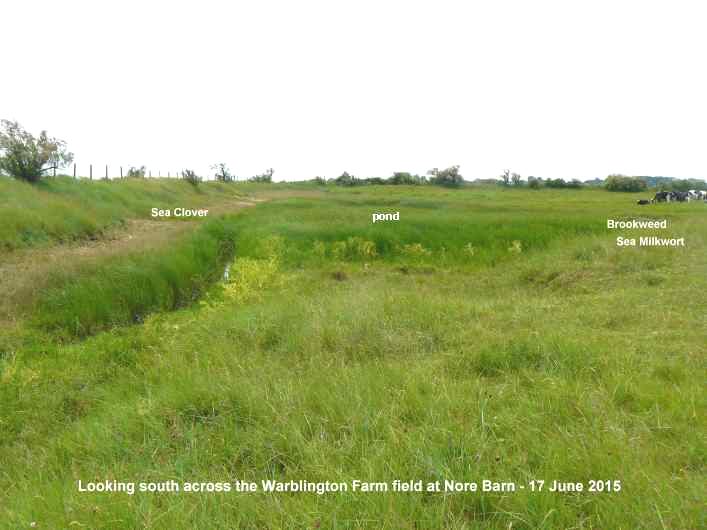
Hampshire
Farm
Chris Oakley
reports from Hampshire Farm this afternoon. Here is
his report:
"The sun was really hot which brought out a multitude
of insects and butterflies. There were Meadow Brown,
Speckled Wood, Small Tortoiseshell, Small White and
two beautiful Adonis Blues but I couldn't get close
enough for a better photo.
Brian's
note - more likely to be Common
Blue?

There was also a
Silver Y moth. The damselflies are at last appearing,
there were both immature Small Red and Common Blues.
Over the pond were two Broad-bodied Chasers which are
always my favourites.
I found more clumps of Grass Vetchling within the pond
enclosure. There were a few Swallows and House Martins
over the water as well as some House Sparrows hopping
on the rafts of weed, they looked very comical. The
Ox-eye daisies are still at their best. There are
Birdsfoot Trefoil, Kidney Vetch and huge patches of
red, white and Alsike Clovers everywhere, which were
full of small and large Red-tailed Bumblebees.
One plant that's puzzling me appears to be a plantain
with round or conical heads, there are a lot scattered
among the more conventional plantains but apart from
their leaves they are noticeably different.
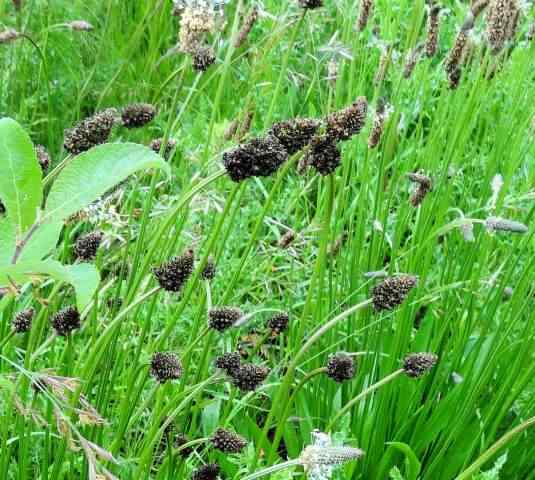
I'm meeting up with
Michele Good and Rachel Moroney tomorrow for a tour of
the site, I'll let you know the outcome."
TUESDAY
JUNE 16 - 2015
East
Head
Jean and I
spent the morning walking round East Head at West
Wittering. From the end of the car park (charge
£6.50) we walked down the east side of the dunes
with the saltmarshes on our right to the end. The view
across the harbour to the downs was spectacular. We
walked back along the sands west of the dunes. The
weather was warm with very little wind, so conditions
were ideal for nature watching. A very good morning
and highly recommended - but not in mid-summer!
My main target was to find the very rare Sea Heath in
flower. I really thought I had found it too, but see
below for my disappointment! However, I did get a
couple of firsts for me by way of compensation along
with lots of other good plants.
Sea
Milkwort
I discovered
what I thought was a good flowering of Sea Heath.
However, Ralph Hollins subsequently pointed out that
the plants I got were in fact Sea Milkwort. This was
disappointing, but this was a good plant for me and a
first. I found the plants are located in two main
spots on the east side of the dunes.
1. small plants on a small island of dense vegetation
on the edge of the dune system at Grid Ref: SZ 76744
98956. Here one can see them standing up with flowers
in the axils.

2. low growing and
extensive on the saltmarshes east of the dunes at Grid
Ref: SZ 76764 98986
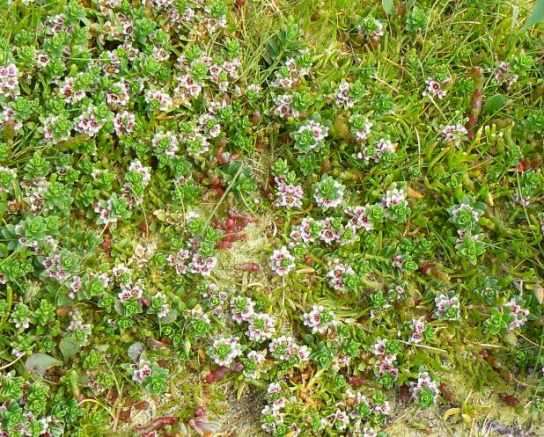
Sand
Couch
I found quite
a lot of this grass growing at the base of the dune
system. It looked at first like a small Sea Couch, but
the spike was clearly different. The most distinctive
feature of this grass is the spike which bears large
spikelets spaced more or less their own length apart
along the stem, which means there is relatively little
overlapping. In sharp contrast, in Sea Couch the
spikelets hug the stem and closely overlap.

Sand Couch is common
in suitable habitats around the entire coast of the
British Isles, but is largely confined to a narrow
zone at the top of sandy beaches and low fore dunes to
landward which is where it grows at East Head. Its
ability to survive and flourish in its disturbed and
hazardous environment is dependent on its perennial
life cycle, extensive rhizome system, ability to grow
vertically through accreting sand, tolerance of saline
conditions and its ability to establish new plants
from seed and fragments of rhizome.
Heath
Groundsel
I found a
large number of these plants growing at the base of
the dune system. At first sight they looked like
extra-large Groundsels, but clearly not as they were
all growing in sand on the dunes. Heath Groundsel
resembles Common Groundsel, but is much larger and its
flower heads have very short ray florets that rapidly
curl under. Groundsel flowers very rarely open. The
whole plant has glandular hairs, but is only slightly
sticky. Heath Groundsel grows not only on heaths, but
also on dunes and sandy soils

Here is a close-up of
the flowers of Heath Groundsel
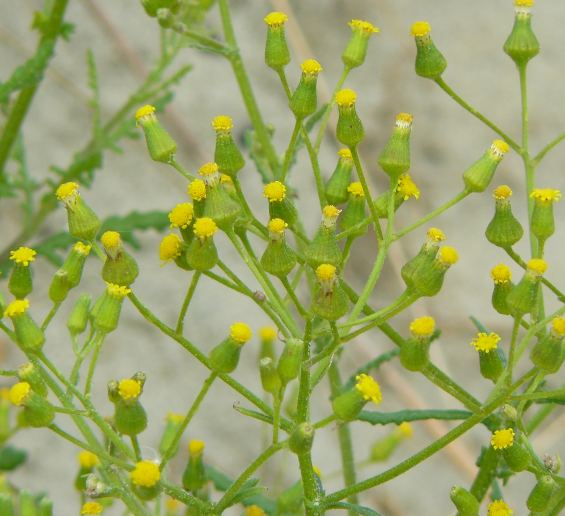 ,
,
Other
plants
Lesser Hawkbit, Glasswort, Thrift, Common
Sea-lavender, Sand Sedge, Sea Spurge, Sea Rocket, Sea
Holly (not in flower), Sea Arrowgrass, Scarlet
Pimpernel , Saltmarsh Rush, Lesser Sea-spurrey, Sea
Plantain.
Left
to right and top to bottom: Glasswort, Lesser Hawkbit,
Sea Rocket, Sea Spurge
Spiked
Star-of-Bethlehem
On the way
home we stopped off at Appledram Lane (south) to have
a look at the Spiked Star-of-Bethlehem
(Ornithogalum pyrenaicum) on the roadside
embankment just before the junction with the main A259
road into Chichester. This is a well-known site for
this nationally scarce plant. I think I first saw it
here in year 2009. The tall elongated flower spikes
with numerous star-like flowers are unmistakable and
they have no difficulty in climbing through the
tangled growth of vegetation on the verge. Today, I
counted 112 flowering spikes pushing, which is about
the same number as I have counted in previous years.
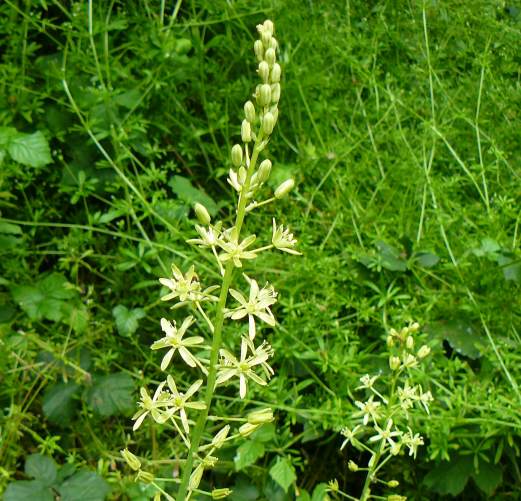
Apparently, this plant
used to be known as 'Bath Asparagus' as the young
shoots were harvested and sold as a substitute for
Asparagus.
Hairy
Bindweed
I also found a
few flowers of Hairy Bindweed (Calystegia
pulchra) in the hedgerow just south of the
footpath sign on Appledram Lane (south). This unusual
plant has large trumpet flowers the size of Large
Bindweed, but with pink stripes, rather like Sea
Bindweed. It gets its name from its hairy flower
stalks. I first discovered it here on 10 June 2009.
The Hants Flora describes it as "very local . . .
found in gardens and hedges near houses, frequently
having been transported with earth."
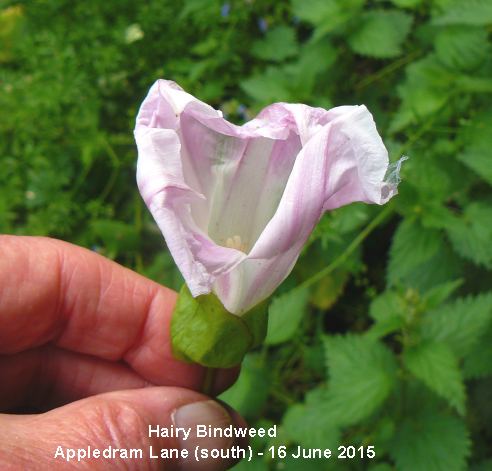
Swifts
Just two
Swifts were feeding high above the houses in
Bridge Road. Swifts have not been at all regular this
year and 4 is the most I have seen at any one time in
this area.
Great
Black-backed Gulls
Sharon Corbett
who originally told me about the Great Black-backed
Gull chicks falling off the Slipper Millpond raft into
the water provided a bit more information about what
she saw. She said each of the chicks fell in on
different days: the first on Wednesday (June 10) and
the second on Saturday (June 13). On each occasion
there seemed to be some sort of altercation with the
nesting Coots which she think caused the gull chicks
to fall into the water.
When I passed the pond at about 10.30 this morning.
The female gull was still maintaining its vigil on the
tall lamp post over the Hermitage Bridge
Langstone
Mill Pond
Peter
Milinets-Raby is back from family holiday to Belarus
with wonderful birdlife. 'A bit like stepping back to
the 1970's in the UK with birds everywhere.' Here is a
cracking Fieldfare that Peter got in Minsk, presumably
a breeding bird in that area.
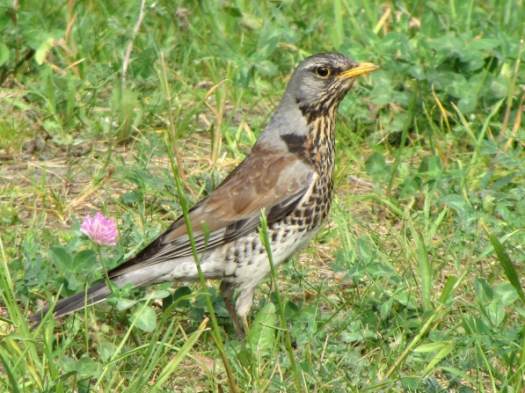
Now he's back to
reality again at Langstone Mill Pond, yesterday
afternoon (2:45pm to 3:45pm - low tide).
Pond: Tufted Duck 2 male and a female - all asleep, 7
Swallow over, 4 House Martin over heading north, Reed
Warbler - 2 singing, Cetti's Warbler, Chiffchaff, Reed
Bunting male, Stock Dove, Very little activity from
the Little Egrets - two fledged fluffy young out of
the nest was all I saw.
Off shore: 3 Common Tern, Little Tern, Sandwich Tern,
3 Med Gulls, Canada Goose, 2 Shelduck.
MONDAY
JUNE 15 - 2015
Great
Black-backed Gulls
Tom Bickerton
sent me a photo of one of the two Great Black-backed
Gull chicks that died on Slipper Millpond over the
weekend. There does not appear to be any obvious
damage to the chick which fits with Sharon's
observation that the chicks fell from the raft and
were unable to get back on and were drowned.
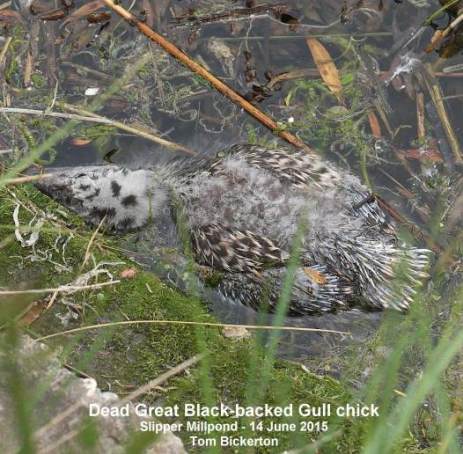
Tom commented as
follows: "I'm at a loss to what caused both birds to
panic. Something made these birds move off the raft,
thoughts tend to lean towards dog or human, but the
adults would certainly attack. Another gull would do
the same, but again the adults have an avian exclusion
zone around the nest. The other predators that would
come to mind would be Mink or a Dog-Otter. Both can
climb onto the raft out from the water. I only found
the one body."
I went down to Slipper
Millpond this afternoon at about 2.30pm to have a look
for myself. The dead chick was still floating in the
water at the eastern end of the bridge with no clear
signs of injury. I was very surprised to see the two
adult Great Black-backed Gulls still perched on the
same lampposts where I saw them yesterday, either side
of the bridge, seemingly holding vigil for their dead
chick. One of the birds (the male) flew off towards
the harbour while I was there, but the other one
(female) remained steadfast on the post watching over
its dead chick in the water below. Do birds really
grieve?
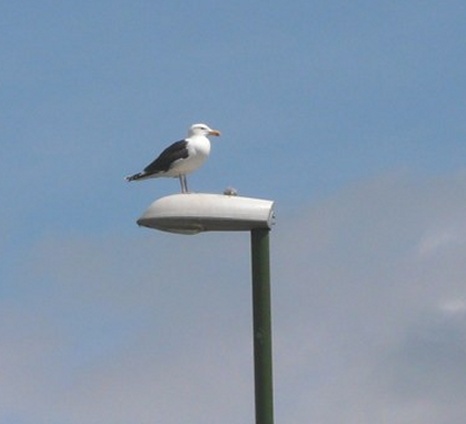
Millpond
Swan family
The swan
family was on the town millpond with the 5 cygnets
constantly upending to feed on nutrients from the
bottom of the pond. They are all growing and looking
healthy. The 'Don't feed the swans bread' notices have
all been taken down; clearly they were not needed any
more, but they did provide useful advice to the
public.
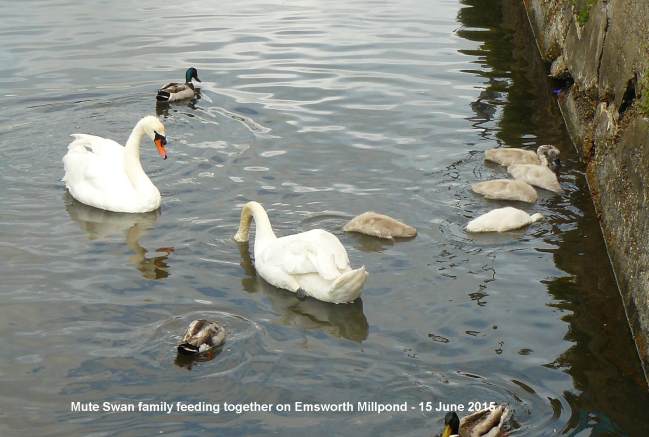
Brook
Meadow
I had a walk
through the meadow this morning with my son and two
young grand daughters who had been staying with us
over the weekend. The girls (6 and 8 years) really
enjoyed walking through the tall grasses on the north
meadow and (as they always do) asked me to cut off a
couple of Butterbur 'umbrellas' for them to hold.
These large leaves are so much loved by children.
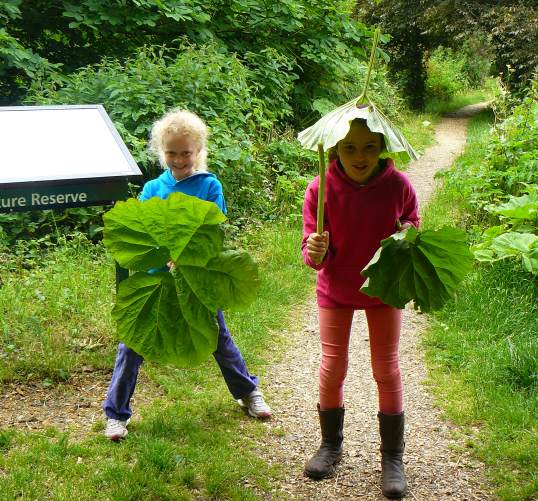
Bee
Orchids
We also had a
look at the orchids in the main orchid area where they
liked the Bee Orchids in particular and actually found
a couple of new ones that I had not previously
recorded. They have sharper eyes than me. Here they
are with the top of one Bee Orchid that I
inadvertantly snapped off while trying to clear away
an entanglement of bindweed. At least, my clumsiness
gave them the opportunity to appreciate the beauty of
the flower at close quarters.
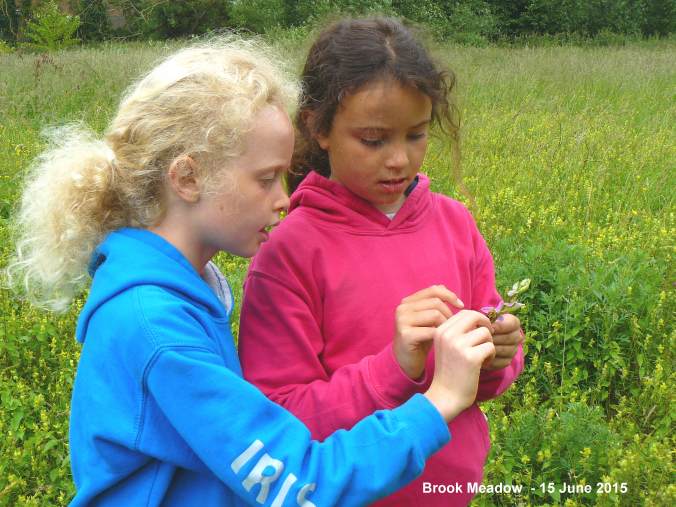
I went back to the
orchid area this afternoon to mark the new Bee Orchids
with twigs and record the grid refs. In fact, I found
there were 10 Bee Orchids in a relatively small area
with more to come I am sure. Together with the three
plants on the Lumley area that takes the total Bee
Orchid count to 13 which is one more than we recorded
last year.
Just after I finished marking the orchids, Barry and
Margaret Collins arrived to see the orchids, so I was
able to guide them carefully through the area to the
main area. They were very pleased to see the orchids
looking so good. I introduced them to Jennifer Rye
(the Brook Meadow Conservation Group Chair) who was in
the process of doing a butterfly transect. Finally,
local orchid enthusiast, Jill Stanley also arrived
with her camera, so we had quite a social gathering,
all for a common purpose - to see some tiny but
beautiful flowers! Jill later e-mailed me to say she
had found another two Bee Orchids in the same small
area as the others, taking the grand total to 15.
Smooth
Brome
Less dramatic,
but equally attarctive in my eyes was the Smooth Brome
(Bromus racemosus) that I found growing
in much the same area as in previous years - on the
cross path north of the Lumley area. It is fairly easy
to distinguish from the more common Soft Brome
(Bromus hordeaceus) due to its looser panicle
which droops more to one side. Smooth Brome is a
fairly uncommon grass, described as 'occasional' in
The Hants Flora. So far this year I have recorded 17
of the 34 grasses on the Brook Meadow list, so there
is a lot more more to come.
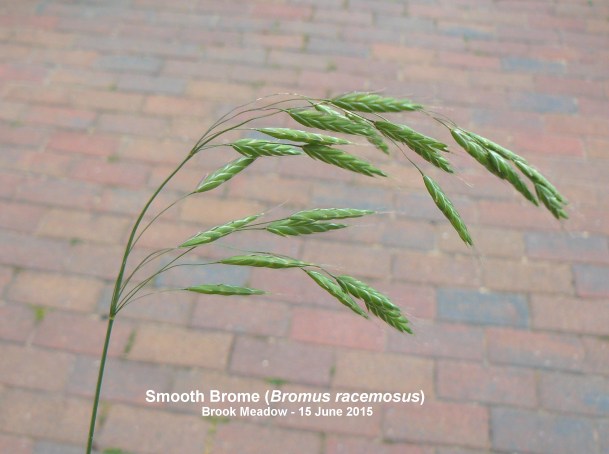
Big-flowered
Vetch
Regarding the
vetch with extra large flowers that Chris Oakley found
on the Hampshire Farm site on June 11, Martin Rand
confirms that it is indeed Common Vetch (Vicia
sativa) but one of the cultivated and
introduced forms. Either subsp. sativa
which used to be grown as a crop plant, or (more
likely because of flower size and colouring) subsp.
cordata, which is still grown as a
silage crop component and also appears in "wild
flower" seed mixes. To make sure, one would have to
see seed pods.
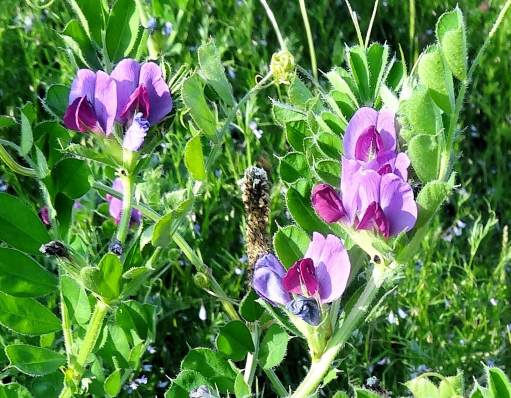
Young
Blackcaps
Lucky Romney
Turner had Blackcaps nesting in her garden this spring
and she was delighted to find they had produced three
fine looking youngsters. Here they are lined up for
some close-up photos. Interesting to see all the
youngsters with chestnut-brown caps just like their
mother. However, they might not all be females as
young males also have brown caps, but this changes to
black by late autumn. What a cracking photo this is.
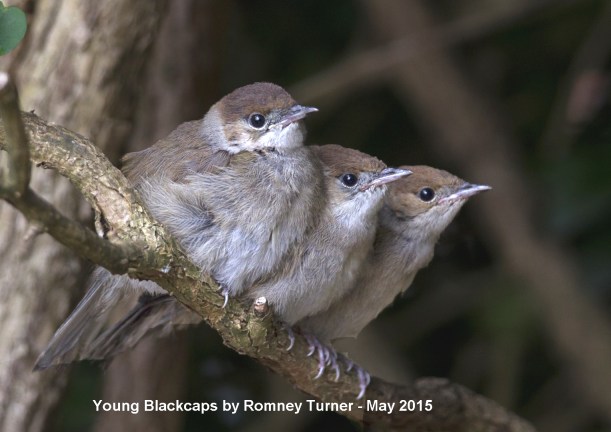
For
earlier observations go to . . June
1-14